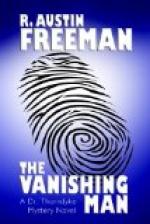1. Do not appear to make minute
investigations or in any way
excite remark.
2. Ascertain if all the bones
belonging to each region are
present, and if
not, which are missing.
3. Measure the extreme length
of the principal bones and compare
those of opposite
sides.
4. Examine the bones with reference
to the age, sex, and muscular
development of
the deceased.
5. Note the presence or absence
of signs of constitutional
disease, local
disease of bone or adjacent structures, old or
recent injuries,
and any other departures from the normal or
usual.
6. Observe the presence or
absence of adipocere and its position,
if present.
7. Note any remains of tendons,
ligaments, or other soft
structures.
8. Examine the Sidcup hand
with reference to the question as to
whether the finger
was separated before or after death.
9. Estimate the probable period
of submersion and note any changes
(as, e.g.,
mineral or organic staining) due to the character of
the water or mud.
10. Ascertain the circumstances (immediate
and remote) that led to
the discovery
of the bones and the names of the persons
concerned in those
circumstances.
11. Commit all information to writing
as soon as possible, and make
plans and diagrams
on the spot, if circumstances permit.
12. Preserve an impassive exterior;
listen attentively but without
eagerness; ask
as few questions as possible; pursue any inquiry
that your observations
on the spot may suggest.
These were my instructions, and, considering that I was going merely to inspect a few dry bones, they appeared rather formidable; in fact, the more I read them over the greater became my misgivings as to my qualifications for the task.
As I approached the mortuary it became evident that some, at least, of Thorndyke’s admonitions were by no means unnecessary. The place was in charge of a police-sergeant, who watched my approach suspiciously; and some half-dozen men, obviously newspaper reporters, hovered about the entrance like a pack of jackals. I presented the coroner’s order which Mr. Marchmont had obtained, and which the sergeant read with his back against the wall, to prevent the newspaper men from looking over his shoulder.
My credentials being found satisfactory, the door was unlocked and I entered, accompanied by three enterprising reporters, whom, however, the sergeant summarily ejected and locked out, returning to usher me into the presence and to observe my proceedings with intelligent but highly embarrassing interest.




